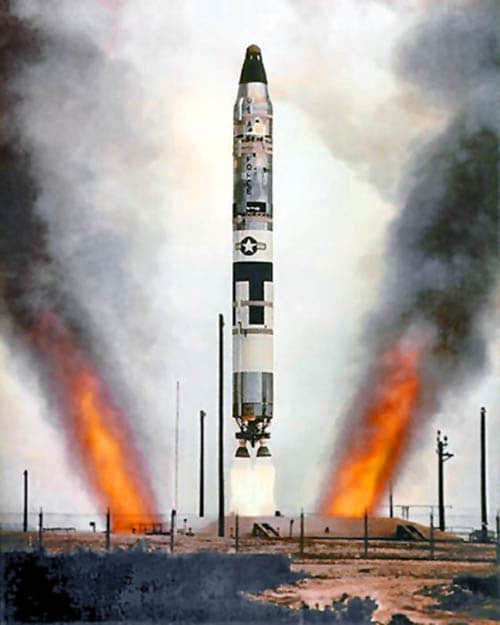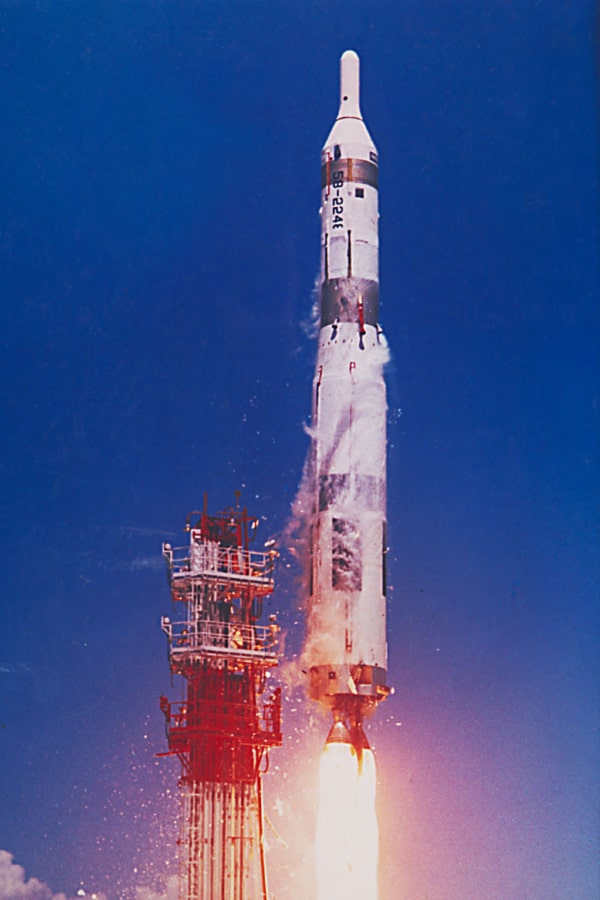21 items, Page 1 of 0

April 25, 2017
The SM-62 Snark was an intercontinental, ground-launched, cruise missile developed by the United States. It was briefly in service between January 1959 and June 1961. Snark Development In August 1945, the U.S. Air Force released a contract requirement stating its interest in a missile capable of carrying a 2,000-pound warhead roughly 5,000 miles. In January...
March 3, 2017
The MGM-52 Lance was a road-mobile, short-range ballistic missile designed by the United States. First deployed in 1972, it served in Europe and South Korea, functioning primarily as a delivery vehicle for battlefield nuclear weapons. MGM-52 Lance Development The Lance was designed as a replacement to the Sergeant and Honest John tactical ballistic missiles. The Lance went into...
December 20, 2016
The SM-78 Jupiter was a medium-range, ground-launched, liquid-fueled ballistic missile developed and deployed by the United States. Due to its limited range, the Jupiter was forward based to allied European countries for deterrence against the Soviet Union. SM-78 Jupiter Development The Jupiter began development in 1954 under the supervision of Dr. Werner Von Braun, with many of...

February 15, 2017
The MGM-31B Pershing 2 was medium-range, road-mobile, solid fueled ballistic missile developed by the United States. Pershing 2 Development The Pershing 2 began development with Martin Marietta in 1974 as a replacement for the U.S. Army’s Pershing 1A missile. It featured an extended range that reclassified the missile from short-range to medium-range, which required revisiting Secretary...

February 15, 2017
The MGM-31 Pershing 1 was short-range, road mobile, solid-fueled ballistic missile developed by the United States. Pershing 1 Development The MGM-31 Pershing was originally built under the name “Redstone-S” to replace the aging Redstone missile, but the missile’s name was changed in honor General John J. Pershing. As the successor to the Redstone, the Pershing inherited...

February 15, 2017
The SM-65 Atlas was an intercontinental, ground-launched, liquid-fueled, ballistic missile. It was the first ICBM developed and deployed by the United States. SM-65 Atlas Development Following the Second World War, the United States sought to produce a ballistic missile able to deliver a nuclear warhead at long ranges. However, due to the weight of nuclear warheads and...

March 22, 2017
The LGM-25C Titan II was the last liquid-fueled intercontinental ballistic missile (ICBM) built by the United States. It was in service between 1963-1987 and could range 15,000 km. Titan II Development The Titan II development program grew out of a 1959 upgrade program which considered adding an in-silo launch capability and improved first and second stage...

March 22, 2017
The HGM-25A Titan I was a liquid-fueled, silo-based, intercontinental ballistic missile built by the United States. Titan I Development The HGM-25A Titan I missile program began in 1954 around the same time as the Thor, Atlas, and Minuteman I programs. The Titan I was designed to function as a secondary ICBM program if the Atlas program failed...

March 3, 2017
The LGM-30 A/B Minuteman I was an intercontinental-range, silo-based ballistic missile, and the first solid-fueled ICBM design developed by the United States and the forerunner of the Minuteman II and Minuteman III missiles. Minuteman I Development As the Cold War progressed and missiles became more numerous and advanced, U.S. defense planners recognized their ICBM arsenal was becoming increasing...
March 22, 2017
The LGM-30F Minuteman II was an intercontinental-range, silo-based, solid-fueled ballistic missile. It was the second generation of the Minuteman ICBM family, following the Minuteman I. Minuteman II Development The LGM-30F Minuteman II development program began in October 1963, less than a year after the Minuteman I entered service. In many respects, the Minuteman II was...

February 15, 2017
The LGM-118 Peacekeeper (MX) was a solid-fueled intercontinental ballistic missile built by the United States designed to attack hardened military targets. Peacekeeper Development The Peacekeeper program began in 1971 as the missile experimental (MX) system as a way to increase the U.S. counterstrike capabilities against the Soviet Union, which at the time was focusing on constructing hardened...

September 5, 2017
The Harpoon (RGM-84/UGM-84/AGM-84) is a U.S.-designed subsonic antiship cruise missile that has been in service since 1977. Numerous variants have been produced since its inception, including air-, ship-, and sub-launched versions. The Harpoon has also undergone multiple upgrades to improve its range and guidance. Variants of the Harpoon have been exported to 32 countries. Harpoon Development...

November 30, 2016
The MGM-140/-164/-168 Army Tactical Missile System (ATACMS) is a series of short-range, road-mobile, solid-propellant fueled, surface-to-surface ballistic missiles developed in the United States. The missile first saw use during the 1991 Persian Gulf War. ATACMS Block 1 The ATACMS was designed to take over the conventional role of the MGM-52 Lance missile, providing tactical support to...

November 29, 2016
The AGM-86 Air-Launched Cruise Missile (ALCM) is a long-range, air-launched standoff missile designed to give U.S. bombers the ability to launch their payload from outside the range of anti-aircraft weapons. It is a central element of the United States strategic bomber force. ALCM Development The ALCM program began in the early 1970s, designed to give...
October 6, 2016
The JASSM (Joint Air-to-Surface Standoff Missile) is a conventional, stealthy, air-launched ground attack cruise missile designed for the U.S. Air Force and international partners. An extended range version, AGM-158B JASSM-ER, was developed alongside the standard variant, and went into service in 2014. JASSM Development The JASSM’s manufacturing and production started in 1998 and the Air...

September 19, 2016
The Tomahawk is an intermediate-range, subsonic cruise missile that is launched from U.S. Navy ships and submarines. It provides a long-range, deep strike capability. The Tomahawk can carry either conventional or nuclear payloads, though policy decisions have phased out their nuclear role. Tomahawk Development The U.S. Navy began its development of sea-launched cruise missiles in 1972. The...

September 19, 2016
The UGM-133 Trident II D5 is a three-stage, solid-fueled submarine-launched intercontinental-range ballistic missile. The Trident D5 missile is deployed by both the United States and United Kingdom on their respective Ohio- and Vanguard-class nuclear missile submarines. Trident Development The UGM-133 Trident II D5 is the U.S. Navy’s latest generation submarine-launched ballistic missile (SLBM). It improved upon...
September 19, 2016
The LGM-30G Minuteman III is a three-stage, solid-fueled, intercontinental-range ballistic missile. The Minuteman III is the sole land-based component of the U.S. nuclear triad. The Minuteman III has a fast launch time, nearly 100 percent testing reliability, and backup airborne launch controllers to preserve retaliatory capabilities. Minuteman III Development The Minuteman family of missiles have...
June 14, 2018
The United States is the world’s dominant military power. But while its arsenal of conventional strike assets contains some of the most sophisticated weapons in the world, much of its strategic nuclear triad forces are aging quickly. Modernization programs are underway, including a replacement for the Ohio-class submarine, next generation land-based ICBMs, a new long-range nuclear capable bomber,...

May 4, 2020
The AGM-114 Hellfire is a short-range tactical missile in use by over two dozen countries. It is mostly used for land-attack missions and has seen widespread employment in the Global War on Terror. The Hellfire is predominately air-launched, although it has also seen limited deployment on sea platforms. Hellfire Development The United States began developing...

March 21, 2022
The FGM-148 Javelin is a man-portable, “fire-and-forget” antitank guided missile (ATGM) system with an effective range of 2.5 km. It was designed to defeat heavily armored vehicles such as main battle tanks and lighter-skinned military vehicles. The weapon also has capability against other target types like fortifications, bunkers, and helicopters. It first entered service with...














